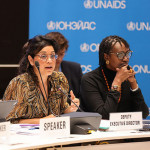Here’s a heartbreaking disparity in the AIDS response: Globally, only half (52%) of children living with HIV are on lifesaving meds, compared with 76% of adults. This means that nearly 1.2 million children and adolescents ages 0 to 19 have untreated HIV.
To address this issue, several international AIDS organizations have joined a new effort to provide HIV care and treatment for children. Specifically, they launched the Global Alliance for Ending AIDS in Children by 2030.
Stakeholders in the alliance include the Joint United Nations Programme on HIV/AIDS (UNAIDS), the World Health Organization, UNICEF, the U.S. President’s Emergency Plan for AIDS Relief and other partners, according to a UNAIDS press release.
What’s more, the first phase of the alliance focuses on 12 countries that have joined the effort: Angola, Cameroon, Côte d’Ivoire, the Democratic Republic of the Congo (DRC), Kenya, Mozambique, Nigeria, South Africa, Tanzania, Uganda, Zambia and Zimbabwe.
According to UNAIDS, the alliance has identified four main pillars for collective action:
- Closing the treatment gap for pregnant and breastfeeding adolescent girls and women living with HIV and optimizing continuity of treatment;
- Preventing and detecting new HIV infections among pregnant and breastfeeding adolescent girls and women;
- Making tests, optimized treatment and comprehensive care for infants, children and adolescents exposed to and living with HIV accessible; and
- Addressing rights, gender equality and the social and structural barriers that hinder access to services.
The report explains the reasons a new and updated alliance is needed:
“There has been remarkable progress in some countries in providing antiretroviral therapy (ART) to pregnant women living with HIV. By the end of 2021, 12 countries in sub-Saharan Africa reached the target of 95% ART coverage in pregnant women; and Botswana was the first high prevalence African country to be validated as being on the path to eliminating vertical transmission of HIV.
“At the global level, however, we are far from ending new HIV infections in children. There are HIV high-burden countries and settings where progress in preventing vertical transmission has flatlined.
“In addition, challenges with the quality of care persist, with poor uptake of testing, gaps in ART initiation, low retention rates and poor adherence to HIV treatment. The COVID-19 pandemic has thrown us further off track—between 2019 and 2021, ART coverage among pregnant and breastfeeding women declined in some countries.”







Comments
Comments